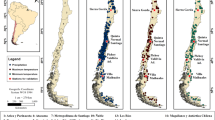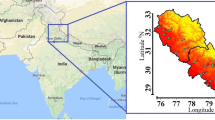Summary
An N–PLS regression technique was tested as an empirical downscaling method. Average monthly near-ground air temperature (t), specific humidity (q), and sea-level pressure (p) fields across Central and Western Europe were used as predictors for average monthly air temperature (T), dew temperature (D), and precipitation amount (P) at 4 locations in Slovenia. The empirical downscaling models (EM) were developed by means of available predictand data from the ARSO archive and predictor data from the NCEP/NCAR reanalysis project, for the period 1951–2002, separately for single months. Using the combination of t and p as predictors, the EM for T explained from 73% to 95% of predictand variability, for D from 74% to 97% of predictand variability, and for P from 31% to 76% of predictand variability. The use of q as an additional predictor did not improve the quality of the EM considerably. Developed EM using p and t as predictors were applied to the results of 5 general circulation models (GCM): CSIRO/Mk2, CCC/CGCM2, UKMO/HadCM3, DOE-NCAR/PCM, and MPI-DMI/ECHAM4-OPYC3. Only the simulations based on SRES A2 and B2 emission scenarios were considered in our calculations. Available mean monthly values of predictors for the period 1951–2100 were used. All the projections of GCM results indicate an increase in T and D and decrease in P in the 21st century at all 4 locations. The expected range of changes in T, D, and P is wide due to the different response of GCM to identical changes in the atmospheric composition, and represents a source of uncertainty in empirical downscaling results. Another important source of uncertainty in empirical downscaling studies, especially when temperature dependent predictors are used, is the problem of extrapolation. By using the proper mathematical approach for EM development we only reduce a part of the uncertainty related to the quality of empirical models that also strongly depend on the quality of input data and predictor selection. The N–PLS regression seems to be a suitable choice of mathematical method, as the feature selection from a large number of predictor time series is not predictand independent. Finally, any climate change and impact studies for the future are affected by many other uncertainties that we have to be fully aware of, while interpreting their results.
Similar content being viewed by others
Author information
Authors and Affiliations
Rights and permissions
About this article
Cite this article
Bergant, K., Kajfež-Bogataj, L. N–PLS regression as empirical downscaling tool in climate change studies. Theor. Appl. Climatol. 81, 11–23 (2005). https://doi.org/10.1007/s00704-004-0083-2
Received:
Revised:
Accepted:
Published:
Issue Date:
DOI: https://doi.org/10.1007/s00704-004-0083-2




